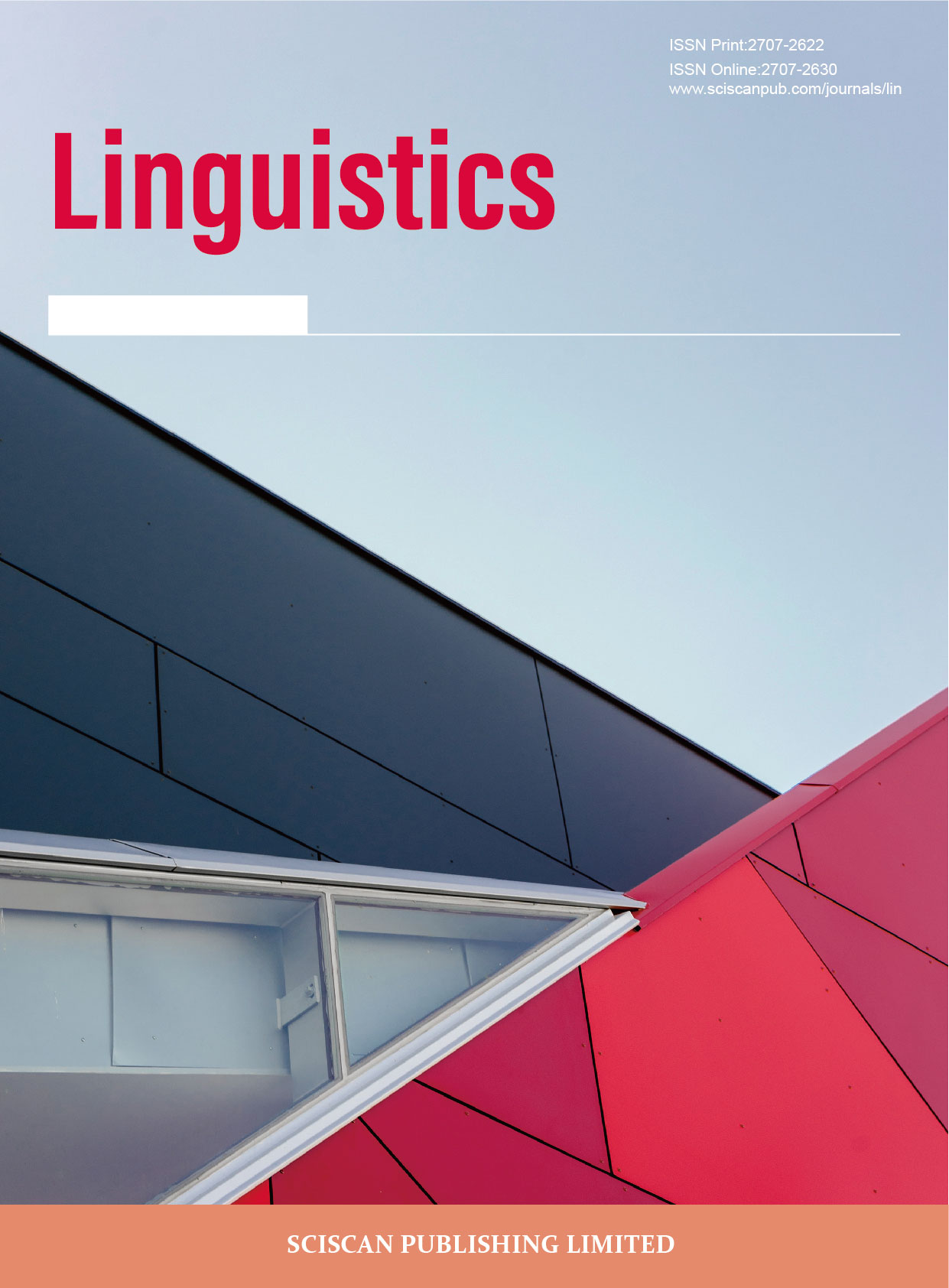在标记理论下的汉日语wh疑问句对照研究
The Labeling of Wh-phrases in Chinese and Japanese
- Authors: 谢韬
-
Information:
东北大学(日本,仙台)
-
Keywords:
Chinese; Japanese; Wh-phrases; Labeling汉语; 日语; wh 短语; 标记
- Abstract: This paper presents an analysis of wh-phrases in Chinese and Japanese, as they demonstrate both sharing properties and distinct behaviors. We attempt to portrait their syntactic features under the current Labeling theory and offer a general account. On one hand, they do have a lot in common in the sense of superficial representations, whereas they differ significantly with respect to interpretation and syntactic operation on the other. Specifically, they are not only subject to different movement constrains, but also vary greatly in terms of methods of interpretation and the sensitivity to root-ness. In general, this paper argues that such different traits can be properly accounted for under the labeling/feature valuation requirement. And if this proposal is defensible, the syntactic idiosyncrasies showcased in this paper can then be captured in a way that accords to the Strong Minimalist Thesis, since both labeling and Agree can be reduced to Minimal Search, which is arguably a third-factor principle. 本文在生成语法学的最新框架下,将汉语和日语中的 wh 短语的诸多异同点进行梳理与总结,并试图立足于标记理论对这些语法现象进行了归纳性的解释。虽然汉语和日语的 wh 短语在表面构造上十分相似,但在具体的语法行为和解释方式上有较多的不同点。尤其是孤岛效果的有无,非限定解释的来源以及根句—嵌入从句的特征对照上,本文提出汉语的这些区别于日语的特征均可从标记以及特性赋值的要求上推导而来。这一分析法很大程度上契合了强最简命题(The Strong Minimalist Thesis),因为无论是标记还是特性赋值均可被精简为被视作一种第三要因定律(The third-factor principle)的最小探查。
- DOI: https://doi.org/10.35534/lin.0304036
- Cite: 谢韬.标记理论下的中日语 wh 疑问句对照研究[J].语言学,2021,3(4):564-579.
1 引言
生成语法的理论框架在近年发生了较为显著的变化,尤其是在Chomsky(2013,2015)提出的投射问题(problems of projection:extension,POPE)框架中,作为句子构建的唯一操作,合并(merge)被重新定义。在先前的Chomsky(1995)中,合并被赋予了标记(labeling)功能,然而在POPE框架下合并不再具备这一功能。新定义的合并可以由下述等式来表示:
(1)Merge(a,b)= {a,b}
然而根据Chomsky(2013)、Narita(2014)的定义,由合并而构成的语法要素(syntactic object,SO)必须获得标记以在概念-意图(conceptual-intentional,C-I)介面获得解读,否则将违反完全解读定理(full interpretation)。在标准理论下,通过最小探查(minimal search,MS)标记可以通过如下两种方式来完成。

在图式(2)中,MS可以清晰地寻得嵌入最浅的中心语,故该SO可以该中心语来标记。然而图式(3)则涉及两个最大投射,MS无法寻得嵌入最浅的中心语所以该SO本应无法被妥善标记。然而在Chomsky(2015)中,两个最大投射若同时包含同类型特性(feature),则该SO可由二者共有的特性来标记,因此图式(3)的SO可被标记为<F,F>。实际上英语的限定时态短语(tense phrase,TP)与wh疑问句即是以如此手段来进行标记。wh疑问句之标记见下述图式:

在图式(4)中,MS可以同时寻得wh短语和CP中的共有特性[Question],所以该SO可以被正确标记为<Question,Question>。
依据上述理论框架,Miyagawa,Wu和Koizumi(2019)主张日语中wh短语的历时变化也是由标记的要求所决定的。与现代日语不同,古日语的wh短语也会和诸多印欧语一样发生位移,例如(5)中意为“何处”的古日语wh短语即从动词补足语位置移动到了句首位置。

而wh短语移动在现代日语中却已消失,并与现代汉语一致都出现在基底位置处。例如(6)中的现代日语句,表“什么”,“谁”的wh短语均出现在原本位置未发生移动:

为解释这一现象,Miyagawa,Wu和Koizumi(2019)提出了日语的导句词(complementizer,C)在历时变化中,所受的支撑(“support” in richards 2016)方法有所不同(a)。具体来说,古日语中C可受wh短语移动的支撑来满足EPP要求,而现代日语中C可由疑问小品词“か”的合并来满足该要求。这一分析也与Marantz(1997)的观点相呼应,即T或C之类的功能词汇本身只是语义上的一个根元(root),此类根元只有在被另外的要素所附着之后才可成为SO并完成投射。而“か”则正是日语中能履行这一功能的附着要素,在与C相结合后,后者即具有独立的范畴地位(category status)。据此,Miyagawa,Wu和Koizumi(2019)将“か”这一类的疑问小品词视为“标记触发者”(labeling inducer)。
乍看之下,Miyagawa,Wu和Koizumi(2019)的结论似乎也能适用于汉语的疑问句分析。正如Aldridge(2015)所指出的一样,先秦汉语亦具有wh短语移动的特征,而这种特征并非基于音韵性的接语化(与Feng,1996之结论相反),而是事实上的语法操作。然而本文则主张不可将本节中对日语的疑问句分析法完全照搬至汉语分析当中,因为二者在语法表征上有较大区别,而本文也将提出一个结合汉语实际语言现象的分析与考察。
2 古今汉语wh短语操作的变化
据Aldridge(2015)的观察,在先秦时代,古汉语的动词短语内wh短语须移动至动词之前主语之后的位置。也即是说,古代汉语中有大量类似(5)的wh短语移动现象。例如(7)所示:

在非wh短语疑问句中,动词“欺”和“克”的宾语都应出现在其右方,然而wh短语则出现在动词的左方,二者的这一区别可由(7a-b)和(7c)的对立所体现。立足于这一现象,Aldridge(2015)将古汉语wh短语移动分析为句内wh移动(clause-internal wh-movement),该分析方法之细节详见于(8)。

此类移动被认为是受到轻动词中心语v的[焦点(Focus)]特性的驱动,且以该轻动词的指示语为目标地(landing site)。这样不仅说明了wh移动在形式上的特征(高于动词但低于主语),还契合了对wh短语移动的主流看法,即该类移动之动机为核查焦点特性。
值得一提的是,现代汉语中的wh短语虽然不再显性移动,但其依旧参与语法运算。其中尤其是Tsai(1999)的非选择性约束(unselective binding)分析法有力地捕捉到了现代汉语wh短语的诸多语法特性。这种分析法可以简要地由(9)中图式来体现:
(9)[CP Op[Q]x[TP …WHx…WHx…]]
得益于(9)中所描绘的句构造,一大重要的经验成果便是对裸条件句(bare conditionals)的解释。如(10)一类的条件句中没有任何条件导句词(如英语的if ),但其中的wh短语却能获得全称量化(universal quantification)解释:

Heim(1982)提出了条件句先天具有全称量化属性的观点,如此一来(10)的句意便可以通过(11)中的构造来体现。这一分析法的另一大概念优势便在于既无须假定现代汉语中有两种不同类型的wh短语也不需要假设汉语wh短语进行了非显性移动(LF-movement),因其释义完全依靠非选择性约束来决定并且始终未发生任何移动。而Tsai(1999)的这一分析法也与很多研究在wh短语的定义上不谋而合(如Lin 1998,Aoun & Li 2003等),即汉语的wh短语应该被视作非限定变量(indefinite variable)。
但是笔者认为,尽管Tsai(1999)的分析正确地指出了现代汉语wh短语的诸多特性,但实际上关于wh短语的解释仍旧有不明了之处。笔者将在第4小节讨论这一问题。
3 现代日语中wh短语的解释
虽然在Miyagawa,Wu和Koizumi(2019)中,现代日语wh短语的“在原位(in-situ)”属性已经通过将疑问小品词视作标记触发者得到了解释,但是如何解读wh短语本身却没有得到完全解答。关于这一点,本文接受Saito(2017)的理论,将日语wh短语视为量化值未特定操作元(unspecified quantificational operator),其通过与疑问小品词搭建Probe-Goal(参照Chomsky,2000)关联来获得特定量化解释。
Saito(2017)首先批判继承了Nishigauchi(1990)和Takahashi(2002)的路线,提出Nishigauchi(1990)所主张的非选择约束无法解释日语wh短语解释中的孤岛效果(wh-island effect)。同时,他也指出Takahashi(2002)的小品词移动(particle movement)分析虽然能解决一些旧问题,但是仍不能解决为何日语中的wh短语无法对等地获得汉语中(10)那样的量化解读。(12)中的wh短语无法获得全称量化解读。

为解决上述问题,Saito(2017)主张日语wh短语会从原位置进行非显性wh移动至一个能探查(probe)到疑问小品词的位置,并通过Agree(参照Chomsky,2000,2004)操作来完成特性的赋值(value)。这一分析可以由以下图式来体现:

通过这一分析法,不仅解决了先前的诸多问题,还解释了为什么日语wh短语对疑问小品词的依赖性。因为如果没有疑问小品词出现,则wh短语无法通过Agree来获得相应的量化解释。
但同时,Saito(2017)的结论也存在一些概念上的瑕疵。其中最明显的便是使用了非显性移动(covert movement)这一操作,考虑到设计Agree操作的初衷之一即是为了消除显性操作和非显性操作的对立,再加上经过非显性移动后的要素是否能参与Agree仍然不明朗这一现状(b),Saito(2017)的这一分析法仍有不完美之处。
为解决这一问题,本文将提出一个基于标记理论的替代方案。简而言之,本文赞成Saito(2017)所主张的日语wh短语无固有量化属性,而日语wh之解释可通过标记来获得。而这一分析法也有赖于Omune(2020)对特性继承(feature inheritance,参照Richards 2007)的重构:特性继承亦是一种Minimal Search。在此大前提下,笔者设C-T间特性继承在wh疑问句和一般疑问句中不完全一致。考虑到wh短语移动普遍被认为由[Focus]特性驱动,而如果这一特性也由T继承的话,wh短语便会通过显在地从动词短语内部移动至T的指示语位置来完成标记。另外鉴于日语wh对疑问小品词的依存性,笔者设疑问小品词所在的C具有[Question]特性。该分析法可以由以下图式来表明:

基于上述构造,当wh短语移动至T的指示语位置时如果特性继承已经执行,则该TP可以被标记为<Focus,Focus>/<Question,Question>,wh短语所携带的未指定特性均可在C-I介面被解读(Epstein,Kitahara和Seely 2016率先提出介面赋值分析)。因为wh短语和T’均是最大投射,所以MS能够顺利地查找到二者的相同特性。值得一提的是,Miyagawa,Wu和Koizumi(2019)指出日语中的格记号如“が”“を”具有“标记阻止者(labeling blocker)”的功能,如此一来(15)这样的宾格wh短语似乎不再能够提供标记。

但事实上,即便(15)中的wh短语不能成为标记,MS依旧会在下一步的搜索中找到最浅嵌入的中心语T,并且只要发生了特性继承,该句在C-I界面仍然会获得和(14)一致的解读。须注意的是,在标准POPE的框架下宾语会在第一个位面节点(phase-level)被转移(transfer),进而无法参与下一步的构造派生(参照Chomsky,2008中的Phase Impenetrable Condition)。但问题是wh短语本身的未赋值特性(unvalued features)此时若未能被赋值,该派生无法在C-I介面获得解读,所以笔者认为宾语wh短语会在v*被合并后移动至其指示语位置以规避转移(关于合并与标记操作的时效自由性,另见Nomura,2020)。
可能会有人提出质疑,如果宾语wh短语成为了T的指示语,是否会和主语竞争这一位置。这一质疑不仅可由多重指示语分析(multiple-specifier analysis,参照Saito, 2014;Epstein、Kitahara and Seely,2020等)解决(c),还可通过设主语会进一步提升至A’位置,并与C一道被标记为<Topic,Topic> 来回答(参照Hayashi,2020)。
另外值得指出的是,日语中的疑问小品词可以脱离wh短语单独存在(也即一般疑问句)。在这种情况下,特性继承则不再重要,因为无论[Focus]特性是否存在/是否被T所继承,也没有wh短语移动可被驱动。该类疑问句的疑问解读则可被认为来源于最后对C的标记:C=か[Question]。
最后,笔者认为(14)所示的标记法同样正确地预测了日语中会存在wh短语孤岛效果。正如Saito(2017:3)指出的一样,因为日语wh短语是经由移动而来,所以才会出现孤岛效果。试观察下述日语嵌入疑问句:

(16)这一嵌入疑问句理论上可有两种解读,若将wh短语视作与低位疑问小品词(即第一个“か”)相联结,则会推导出合理的“解读一”。但是,如果将wh短语视作与高位疑问小品词(即第二个“か”)相联结,则会推导出相当牵强的“解读二”。针对这一现象,Saito(2017)认为当wh短语移动至低位CP的边际(Edge)时,便已经可以被妥当地解读为疑问操作元(interrogative operator),所以不需要再进一步上移。日语的这一现象也契合了Rizzi(2010)所提出的 “标准性冻结(criterial freezing)”条件(d):wh短语在进行了第一次移动后便被“冻结”在此,不再参与进一步的派生。
4 现代汉语wh疑问句的标记
正如笔者在第二小节所述,在现代汉语的疑问句中也存在选择性的约束关系。作为对照,尽管日语中存在量化(existential quantification),一般疑问句和wh短语疑问句均可由同样的疑问小品词“か”来体现,但现代汉语中没有与日语这一特征相平行的语言现象。十分明显,汉语的疑问小品词“吗”不能赋予wh短语疑问解读而“呢”却只能赋予wh短语疑问解读而不能赋予其存在量化解读。试观察下述疑问小品词的对立:

诸如“什么”一类的wh短语在没有疑问小品词出现的情况下既可以被解读为疑问wh短语也可以被解读为存在量化。例如“你吃什么?”和“什么着火了”,但是一旦句末出现“吗”则该wh短语只能被解读为存在量化。与之相反,如(18)所示疑问小品词“呢”仅能提供疑问句解读。如果我们吸收Tsai(1999)的非选择性约束分析的话,我们或许就需要假设一个操作元同时兼备两种量化能力。就算我们将这一假设缺乏理论背景支撑这一缺点先搁置一旁,也难以解释为什么“吗”仅有在句子中出现wh短语时才通过非选择性约束为其赋予存在量化解读。另外,尽管笔者同意将汉语wh短语视作非限定变量,如此一来其本身就应该具有存在量化属性。但一个不受操作元约束的变量也脱离了现行理论框架中的基本概念设计。
还须指出的是,第三小节中所论述的针对日语wh短语的分析也不能套用在汉语wh短语之上。二者间一个很大的差别就是当日语wh疑问句充作嵌入从句时疑问小品词不可脱落,而汉语wh疑问句在此情景下不可和疑问小品词同时出现。该对立可由(19)之例句展示:

如(19b)所示,当“吗”居于下位嵌入从句内时该句不合语法,(19b)仅在“吗”作为主句的疑问小品词时方可成立,此时解读也会发生变化,疑问的对象会相应地转变为“知道”。与之相对的是,日语中的wh疑问句在充当嵌入从句时必须和“か”同时出现。在本节的后续部分笔者将该现象归结于标记完成后的转移(transfer)操作。
汉日语wh短语的另一大差异便是孤岛效果的有无。如(16)所展示的一样,日语中的wh短语受制于孤岛效果的制约,但是汉语中的wh短语却不受该制约。这也与Tsai(1999)的分析相契合,因为汉语wh短语通过合并与C相结合,此类联结关系与移动无关。参见下述例句:

综上所述,本小节的主要目标有两点:(1)说明“吗”和“呢”在wh短语句构造上的不同表现;(2)说明为何汉语中wh疑问句作嵌入从句时不可与疑问小品词同时出现。而笔者将试图从标记理论的视角出发寻求解决办法。
首先,基于“吗”不可与疑问wh短语同时出现这一事实,笔者认为汉语中的wh短语的具体解读应该通过赋值或标记来确定。同时,“吗”这一疑问小品词除wh短语疑问句以外,也普遍出现在一般的极性疑问句中。因此,将其所含有的特性设置为[vQuestion]应该十分合理,与此同时如果我们设wh短语也含有对应的未赋值特性[uQuestion]的话,再加上汉语wh短语的固有非限定性,便会得到如下构造:

虽然该构造中不会出现标记问题,但也缺乏对wh短语进行赋值的手段。而C和wh短语之间也无法建立合法的Agree联结,根据Chomsky(2000,2004)的定义,Agree联结之间不能出现干扰物(intervener),但在(21)中T则会成为潜在的干扰物。 而只要Agree联结无法得到建立,特性的赋值(valuation)就也无从谈起。从结论上来说,wh短语的[uQuestion]无法在这一构造中得到赋值,最终在C-I介面中也就不能获得解读。另一方面,当[uQuestion]无法被解读时,wh短语则只能被解读为非限定短语,并且因为获得了解读所以不会违反Full interpretation.
与之相反,汉语中的“呢”天然就具有[Focus]特性,而这一推论并非只是约定式的假定条件。和“吗”不同,“呢”还能表达除疑问以外的意义,其中就包括强调与肯定的用法。

(22a-b)在句意解读上具备加强语气与命题可信度的功能,而(22c)中的“呢”甚至可以改变句子的音韵结构,不仅造成了句子的中断还将重读中心加诸主语之上。在此之上,wh短语移动普遍被认为是受[Focus]特性的驱动,所以笔者在此提出“呢”管辖下的wh短语出现了移动。这种构造可由(23)体现:

关于具体的赋值与标记,笔者作如下分析:C的[Question]特性由T继承,凭此TP将被标记为<Question,Question>,而“呢”自身所触发的强调功能也将由对CP的标记来体现:CP被标记为C[Focus](e)。
综上,“吗”和“呢”和wh短语间关系的不同可由不同的特性赋值构造与标记结果来解释。
接下来,笔者将讨论为何嵌入wh疑问句不能和疑问小品词同时出现。从这一现象出发,一个很直观的结论就是该类以“吗”或“呢”结尾的句子被局限为根句(root clause),而这种根句属性能够以何种方式在POPE理论框架下得到解决呢?就这一个问题,本文的观点与Miyagawa,Wu和 Koizumi(2019)有共通之处。或是将“吗”和“呢”视作在和C合并之后会成为C的标记阻止者,或者将“吗”和“呢”分析为转移触发者(transfer inducer)。无论采取何种分析法,一旦“吗”和“呢”通过合并进入派生,现有结构的派生都会在这一时间点结束,并分别进入C-I介面和S-M(sensorimotor)介面。故无法再成为另一根句的嵌入从句。
5 结语
本文基于POPE理论中的标记要求,对汉语和日语的wh短语进行了对照分析。首先,虽然汉语和日语在wh疑问句上有类似之处,但是并不能将对日语的分析法完全套用至汉语之上。本文对诸多先行研究进行批判性继承,并将汉日语wh短语的语法特征归结为标记与特性赋值的要求。简而言之,笔者认为日语的wh短语会离开动词短语内的初始位置并在T的指示语处完成特性赋予与标记。与之相对,汉语的wh短语在上移的基础之上还需要通过与不同的疑问小品词建立联结方可形成正确的派生结果。而根据具体的疑问小品词,其间特性的指定与继承均非完全一致。在此之外,疑问小品词所触发的根句属性亦可通过POPE理论下的转移操作来解释。
参考文献
[1] Chomsky N.Problems of projection[J].Lingua,2013(130):33-49.
[2] Chomsky N.Problems of projection:Extensions[M]//Structures,strategies,andbeyond:Studies in honour of Adriana Belletti,ed.E.Domenico,C.Hamann & S.Matteini.Amsterdam:John Benjamins Publishing Company,2015:3-16.
[3] Chomsky N.The Minimalist Program[M].Cambridge,MA:MIT Press,1995.
[4] Narita H.Endocentric structuring of project-free syntax[M].Amsterdam:John Benjamins,2014.
[5] Miyagawa S,Wu D,Koizumi M.Inducing and blocking labeling[J].Gloss:a journal of general linguistics,2019,4(1):2-16.
[6] Richards N.Continuity theory[M].Cambridge,MA:MIT Press,2016.
[7] Marantz A.No escape from syntax:Don’t try morphological analysis in the privacy of your own lexicon[J].University of Pennsylvania Working Papers in Linguistics,1997,4(2):201-225.
[8] Aldridge E.Clause-internal wh-movement in Archaic Chinese[J].Journal of East Asian Linguistics,2015(19):1-36.
[9] Feng S.Prosodically constrained syntactic changes in early archaic Chinese[J].Journal of East Asian Linguistics,1996(5):323-371.
[10] Miyagawa S.EPP,scrambling and wh-in-situ[M]//Michael Kenstowicz(eds.),Ken Hale:A life in Language.Cambridge,MA:MIT Press,2001:293-338.
[11] Tsai D,W-T.On lexical courtesy[J].Journal of East Asian Linguistics,1999(8):39-73.
[12] Heim I.The semantics of definite and indefinite noun phrases[M].Amherst:University of Massachusetts at Amherst dissertation,1982.
[13] Lin J.On existential polarity in wh-phrases in Chinese[J].Journal of East Asian Linguistics,1998(7):219-255.
[14] Joseph E.Aoun,Y-h Audrey Li.Essays on the Representational and Derivational Nature of Grammar:The Diversity of Wh-Constructions[M].Cambridge,MA:MIT Press,2003.
[15] Saito M.Japanese wh-phrase as operators with unspecified quantificational force[J].Language and Linguistics,2017,18(1):1-25.
[16] Chomsky N.Minimalist Inquiries[M]//Martin,R.et al.(Eds.),Step by Step:Essays in Minimalist Syntax in Honor of Howard Lasnik.Cambridge,MA:MIT Press,2000:89-155.
[17] Nishigauchi T.Quantification in the theory of grammar[M].Dordrecht:Kluwer,1990.
[18] Takahashi D.Determiner raising and scope shift[J].Linguistic Inquiry,2002,33(4):575-615.
[19] Chomsky N.Beyond Explanatory Adequacy[M]//Belletti,A.(Ed.),Structures and Beyond:The Cartography of Syntactic Structures,Volume 3.Oxford:Oxford University Press,2004:104-191.
[20] Omune J.Reformulating pair-Merge,Inheritance and Valuation[D].Doctoral Dissertation.Kansai Gaidai University,2020.
[21] Richards M.On feature inheritance:An argument from the Phase Impenetrability Condition[J].Linguistic Inquiry,2007(38):563-572.
[22] Samuel D.Epstein,Hisatsugu Kitahara,Daniel Seely.Phase cancellation by external pair-Merge of heads[J].Linguistic Review,2016(33):87-102.
[23] Chomsky N.On phases[M]//Foundational issues in linguistic theory,ed.R.Freidin,C.P.Otero & M.L.Zubizarreta.Cambridge,MA:MIT Press,2008:133-166.
[24] Nomura M.Labeling and Pair-Merge of Heads[J].Nanzan Linguistics,2020(15):1-24.
[25] Saito M.Case and labeling in language without φ-feature agreement[M]//On Peripheries:Exploring clause initial and clause final positions,ed.by Anna Cardinaletti,Guglielmo Cinque & Yoshio Endo.Tokyo:Hituzi Syobo,2014:269-297.
[26] Epstein S,D H Kitahara,T D Seely.Unifying Labeling under Minimal Search in “Single-” and “Multiple-Specifier” Configurations[J].Coyote Papers:Working Papers in Linguistics,Linguistic Theory at the University of Arizona,2020(22):1-12.
[27] Hayashi N.Labeling without Weak Heads[J].Syntax,2020,23(3):275-294.
[28] Rizzi L.On some properties of criterial freezing[M]//The Complementizer Phrase:Subjects and Operators,ed.by E.Phoevos Panagiotidis.Oxford:Oxford University Press,2010:17-32.
(a) Richards(2016)最初使用这一术语用来指代英语中时态中心语T的EPP(Extended Projection Principle)特性得到妥当地核查。而Miyagawa(2001)则将这一机制拓展到了导句词的EPP特性核查。
(b) 在标准Agree操作中,以英语为例,主语从动词短语内移动至T的指示语位置主要受强特性之驱动(例如EPP特性),而此类移动均是显性移动。
(c) 但若采用此分析法,则将面临一个隐忧,即难以确定TP的独一标记(Unique labeling)。因为wh短语和主语会同T产生不同的特性核查关系。但如果仍然将格记号视为标记阻止者的话,该问题将不再存在。
(d) 例如英语中的whether不会进一步提升至比主动词wonder更高的位置。
i. I wonder whether you could help me.
ii. *Whether I wonder you could help me.
(e) 同对日语的分析一致,笔者认为汉语主语也会上移至左侧周边部(Left periphery)并成为<Top,Top>标记的一部分。
















